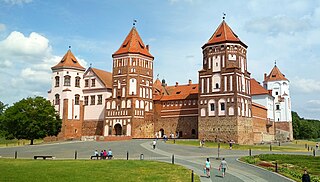
Grodno Region, also known as Grodno Oblast or Hrodna Voblasts, is a region of Belarus. Its administrative center and namesake, Grodno, is the largest city in the region. As of 2024, it has a population of 992,556.

Belarus is an Eastern European country with a rich tradition of folk and religious music. The country's folk music traditions can be traced back to the times of the Grand Duchy of Lithuania. The country's musical traditions spread with its people to countries like Russia, Canada, United States, Kazakhstan and Latvia. The people of Belarus were exposed mostly to Russian pop music during this period and also after independence in 1991. In 2002, however, President Alexander Lukashenko has signed a decree requiring 50% of all FM broadcast music to be Belarusian in origin, and since 1 January 2005 the rule has been even stricter. However, it does not regulate the language of the songs, so most of the music which is broadcast is still in Russian.

Iwye is a town and former shtetl in Grodno Region, Belarus. It serves as the administrative center of Iwye District. It is located 158 kilometres (98 mi) east of Grodno. It is a station on the railway line between Lida and Maladzyechna. The population of Iwye was 8,900 in 1995. As of 2024, it has a population of 7,089.

Polonization or Polonisation is the acquisition or imposition of elements of Polish culture, in particular the Polish language. This happened in some historic periods among non-Polish populations in territories controlled by or substantially under the influence of Poland.
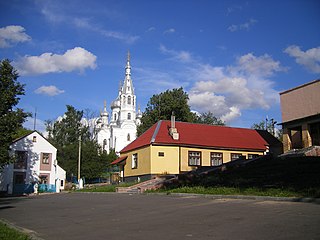
Kamyenyets or Kamenets, also known as Kamyanyets, or קאַמעניץ in Yiddish, is a town in Brest Region, Belarus. It serves as the administrative center of Kamyenyets District. The town is located in the northwestern corner of Brest Region on the Lyasnaya River, about 40 kilometres (25 mi) north from Brest. The Leśna Prawa river flows through the town. In 2002, its population was approximately 9,000. As of 2024, it has a population of 8,287.

The Intercession of the Theotokos, or the Protection of Our Most Holy Lady Theotokos and Ever-Virgin Mary, is a Christian feast of the Mother of God celebrated in the Eastern Orthodox and Byzantine Catholic Churches on October 1 . The feast celebrates the protection afforded the faithful through the intercessions of the Theotokos.

Lahoysk is a town in Minsk Region, Belarus. It serves as the administrative center of Lahoysk District. As of 2024, it has a population of 15,565.

The Belarusian Greek Catholic Church, or the Belarusian Byzantine Catholic Church, is one of the 23 Eastern Catholic sui iuris particular churches that are in full communion with the Holy See. It is the heir within Belarus to the Union of Brest and the Ruthenian Uniate Church.

The Catholic Church in Belarus is part of the worldwide Catholic Church, under the spiritual leadership of the Pope in Rome. The first Latin Church diocese in Belarus was established in Turaŭ between 1008 and 1013. In the subsequent centuries, Catholicism gradually became a dominant religion of Belarusian nobility and of a large part of the population of West Belarus.
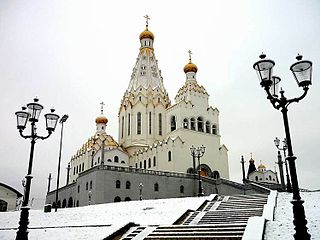
Christianity is the main religion in Belarus, with Eastern Orthodoxy being the largest denomination. The legacy of the state atheism of the Soviet era is apparent in the fact that a proportion of Belarusians are not religious. Moreover, other non-traditional and new religions have sprung up in the country after the end of the Soviet Union.

Iwye District or Iŭje District is a district (raion) of Grodno Region in Belarus. The administrative center is Iwye. Another notable settlement is Hyeranyony, a small historic town with two Category II objects of national cultural heritage. As of 2024, it has a population of 19,524.
The Archeparchy of Polotsk-Vitebsk was an archeparchy of the Ruthenian Uniate Church that was situated in the Polish–Lithuanian Commonwealth. From 1596 to 1839, it was a suffragan eparchy of the Metropolis of Kiev, Galicia and all Ruthenia. The cathedral church of the archeparchy was Cathedral of Saint Sophia in the city of Polotsk.
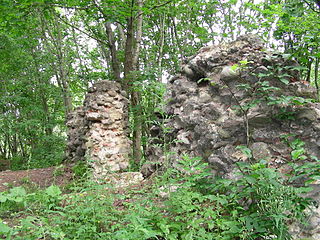
Hieraniony or Gieraniony Castle is a ruined castle near the village of Hieraniony in Iwye District, Belarus. It was constructed in the beginning of 16th century as the main residence of Albertas Goštautas, one of the most powerful noblemen in the Grand Duchy of Lithuania. Later it belonged to the Sapieha and Kiszka families. It was destroyed by the Russian army during the Russo-Polish War (1654–67).
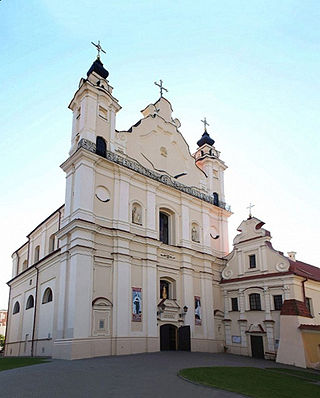
The Cathedral Basilica of the Assumption of the Blessed Virgin Mary also called Pinsk Cathedral, is an eighteenth-century Catholic Baroque-style temple in Pinsk, Belarus.
Belarusian Germans formed a notable ethnic minority on the lands of modern Belarus before World War I.

Church of the Nativity of the God's Mother is an Eastern Orthodox church in Muravanka, Shchuchyn District, Hrodna Province, in Belarus. It is an example of the Belarusian Gothic and one of the first fortified churches in the Grand Duchy of Lithuania along with the Church of St. Michael in Synkavichy.

The architecture of Belarus spans a variety of historical periods and styles and reflects the complex history, geography, religion and identity of the country. Several buildings in Belarus have been designated as UNESCO World Heritage Sites in recognition of their cultural heritage, and others have been placed on the tentative list.

Lithuanians in Belarus have a long history, as the lands of what is now Belarus was part of Lithuania for more than half a millennium from the 13th century onwards. The land of what is now Belarus was originally inhabited by Balts, while Slavs arrived in those lands during the late Early Middle Ages.















